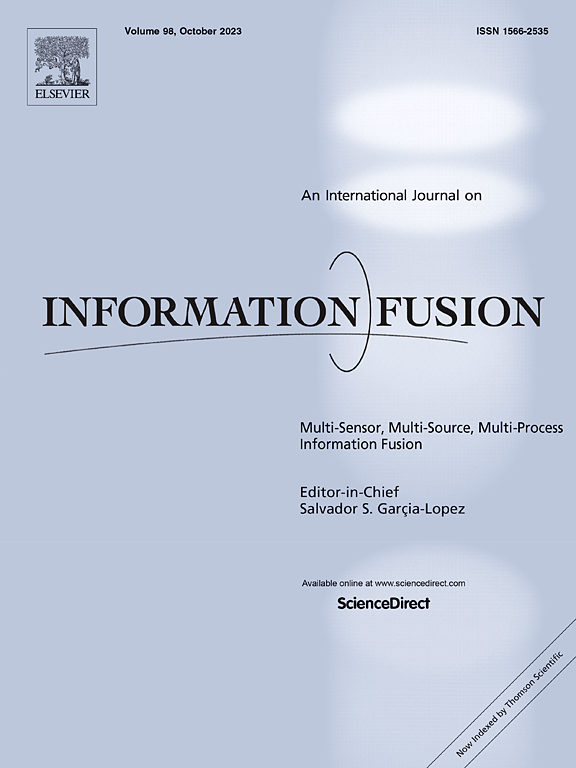LPM-Net: Lightweight pixel-level modeling network based on CNN and Mamba for 3D medical image fusion
IF 14.7
1区 计算机科学
Q1 COMPUTER SCIENCE, ARTIFICIAL INTELLIGENCE
引用次数: 0
Abstract
Deep learning-based medical image fusion has become a prevalent approach to facilitate computer-aided diagnosis and treatment. The mainstream image fusion methods predominantly rely on encoder–decoder architectures and utilize unsupervised loss functions for training, resulting in the blurring or loss of fused image details and limited inference speed. To resolve these problems, this paper presents a pixel-level modeling network for effective fusion of 3D medical images. The network comprises three structurally identical branches: an unsupervised fusion branch and two supervised reconstruction branches. In the fusion branch, the feature extraction modules utilize the dense convolutional neural network and Mamba to extract image features based on axis decomposition. The base and detail components are then predicted from these extracted features and fused to generate the fused image pixel by pixel. Notably, two reconstruction branches share the parameters of feature extraction modules with the fusion branch and provide the supervised loss, which is integrated with the unsupervised loss to enhance the fusion performance. The experiments on six datasets of multiple modalities and organs demonstrates that our method achieves effective medical image fusion by preserving image details effectively, minimizing image blurring and reducing the number of parameters. Meanwhile, our method has significant advantages in eight fusion metrics over the compared mainstream methods, and it provides relatively fast inference speed (e.g., 90 volumes/s on the BraTS2020 dataset). Indeed, our method will provide valuable means to improve the accuracy and efficiency of image fusion-based diagnosis and treatment systems. The source code is available on GitHub at https://github.com/coolllcat/LPM-Net.
LPM-Net:基于CNN和Mamba的轻量级像素级建模网络,用于3D医学图像融合
基于深度学习的医学图像融合已经成为一种促进计算机辅助诊断和治疗的流行方法。主流的图像融合方法主要依赖于编码器-解码器架构,并利用无监督损失函数进行训练,导致融合图像细节模糊或丢失,限制了推理速度。为了解决这些问题,本文提出了一种像素级的三维医学图像有效融合建模网络。该网络由三个结构相同的分支组成:一个无监督融合分支和两个有监督重构分支。在融合分支中,特征提取模块利用密集卷积神经网络和Mamba基于轴分解提取图像特征。然后根据这些提取的特征预测基底和细节分量并进行融合以逐像素生成融合图像。值得注意的是,两个重构分支与融合分支共享特征提取模块的参数,并提供有监督损失,将有监督损失与无监督损失相结合,提高融合性能。在6个多模态和多器官数据集上的实验表明,该方法有效地保留了图像细节,减少了图像模糊,减少了图像参数,实现了有效的医学图像融合。同时,与主流方法相比,我们的方法在8个融合指标上具有显著优势,并且提供了相对较快的推理速度(例如,在BraTS2020数据集上达到90卷/秒)。我们的方法将为提高基于图像融合的诊断和治疗系统的准确性和效率提供有价值的手段。源代码可在GitHub上获得https://github.com/coolllcat/LPM-Net。
本文章由计算机程序翻译,如有差异,请以英文原文为准。
求助全文
约1分钟内获得全文
求助全文
来源期刊

Information Fusion
工程技术-计算机:理论方法
CiteScore
33.20
自引率
4.30%
发文量
161
审稿时长
7.9 months
期刊介绍:
Information Fusion serves as a central platform for showcasing advancements in multi-sensor, multi-source, multi-process information fusion, fostering collaboration among diverse disciplines driving its progress. It is the leading outlet for sharing research and development in this field, focusing on architectures, algorithms, and applications. Papers dealing with fundamental theoretical analyses as well as those demonstrating their application to real-world problems will be welcome.
 求助内容:
求助内容: 应助结果提醒方式:
应助结果提醒方式:


